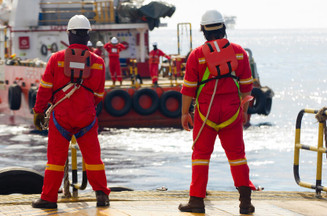Mar 15th 2021
Safety At Sea - Covid-19 Procedures
In a first response to pandemic, On February 21, 2020, IMO issued the Circular Letter 4204/Add.2 on Joint Statement IMO-WHO on the Response to the COVID-19 Outbreak, the main aim of the circular was to prepare for the pandemic hit shipping industry, the sudden spread of virus terrorized governments and this was the reason that in first few months, the seafarers faced some of the worst situation, when they were repeatedly denied entry into their disembarking ports. Convention on the Facilitation of Maritime Traffic explicitly calls for the no delay in maritime traffic, ships and persons and they must not be denied entry into ports, FAL is for greater governmental synchronization with the shipping industry.
The Ocean is a fateful place as humans are up against the most challenging circumstances, when they traverse the earth’s oceans. But the modern maritime industry is considered as safer due to the large number of global safety regulations. These regulations and rules are also known as International Maritime Organization IMO codes. The modern shipping industry; both shore based in the form ports and the seaborne component, the vessels, and offshore platforms, have over dozen of codes. These codes are instrumental in bringing the safety to seafarers. But the shipping industry was less or ill prepared for the pandemic like situation, and this is the reason that it was badly hit in the early few months of pandemic, which took heavily physical and psychological tool on the seafarers and the shipping industry as a whole. There are over twenty IMO codes, under the broader SOLAS convention also known as The International Convention for the Safety of Life at Sea, and is the main safety related convention, having 16 chapters or IMO codes. As all these codes were in place strictly, but the sudden onset of Covid-19, made it harder for the shipping industry to cope the dangerous situation quickly and decisively, as there were no hard and fast rules for the implementation. The safety at sea codes are not just for the cargo ships, but it is also for the luxury cruise shipping industry as well, due to the compactness of the vessel, the seafarers and those travelling via cruise ships are the highest risk of contracting the coronavirus. The sea conditions vary from that of land, and this makes the life of virus vary greatly, as according to some sources the coronavirus found in cruise ships show sign of no decay even after 13 days on the surfaces. To maintain safety at sea, the International maritime organization come up with a series of protocols to be implemented for the safety of workers, which include pre boarding measures, post boarding measures and outbreak management at ship plan. The World Health Organization and Shipping corporations devised their own rules, in synchronization with existing IMO codes. The IMO issued a series of new protocols to be adopted, in which long tours are encouraged, as the normal era routine of quick disembarking and change or crew can cause a sudden outbreak aboard a ship, while the prolonged stay at sea can create a safe working environment for months. The IMO Coronavirus Circular letter No.4204/Add.14 is a part of these protocols, this sixty one pages document laid out a detailed plan for the crew change in these extraordinary times. The letter clearly explains various steps to halt the spread of coronavirus.
These steps include:
- 1.PPE must be loaded into every ship
- 2.All the safeguard measures must be in line with the pandemic response
- 3.Focus must be on screening threats in the working environment
- 4.Must be loaded into the Safety Management system (SMS)
The circular issued by IMO, is not only limited at telling the Seafarers that what to adopt and what to avoid but it also lay out a detail look at the overall institutional response, as seafarers travel through various airports in a bid to reach their port of origin, from where their ship starts its journey, there must be a strict quarantine protocols and facilities to save ship from becoming a pandemic hubs. The IMO circular also suggest to maintain a WHO advised social distance protocols even on board a ship for the initial one or two weeks of embarking on a ship. Instead of staying inside, the seafarers should use external stairways for the movement during their duty hours. The disinfection of workplace and place of rest is advised so that it can remove any possibly left contagion from the surfaces of the ships which compact and closed and thus poses a risk as it can serves as the fertile ground for the contagion for several weeks. The IMO cover letter related to COVID protocols also calls explicitly for testing everyone in the chain of duty, even the ones with possible assignments on ship in the upcoming weeks or months, so they have a prior health confirmation that they are carrier of contagion.
The IMO issued strict guidelines are not just for shipping corporations, but to governments around the globe, to provide ample support and facilities to the shipping sector both private and public to protect ships from the coronavirus outbreak. The IMO Circular Letter No.4204/Add.6 was the initial response to the pandemic situations and thus laid out a clear and concise plan of action. The IMO clearly highlights the port state course of action as well the flag state course of action, as neither can shy away from their duty to maintain high standards of safety in these extraordinary times. The shipping industry is famous for following the checklist guidelines and Standard Operating Procedures and thus remain safe most of the time, the new guidelines and protocols, are different from the traditional IMO Codes, but due to year round practice with all these codes, the shipping industry seem to have trumped the Covid-19 up until now, as it is maintaining strict control of the ports and ships and following the testing and efficient quarantine policy, to keep the contagion at bay.

